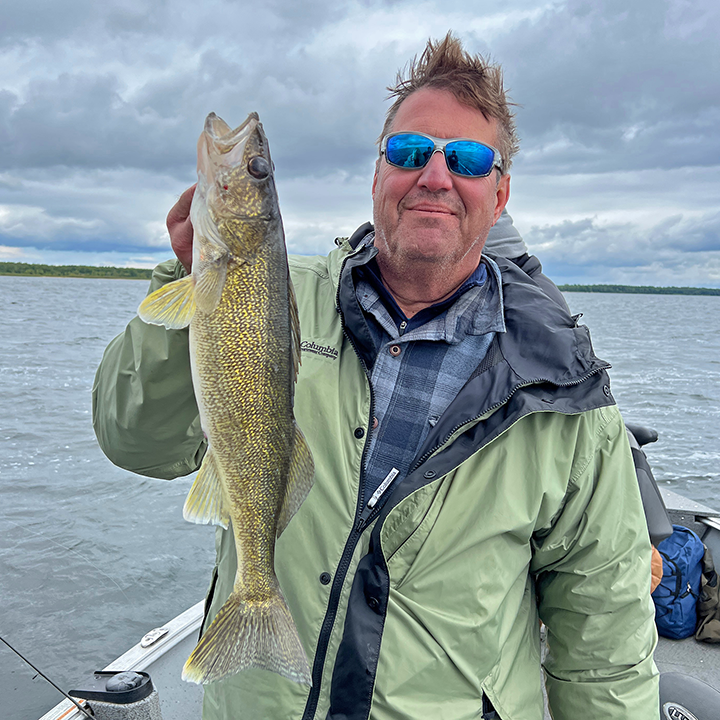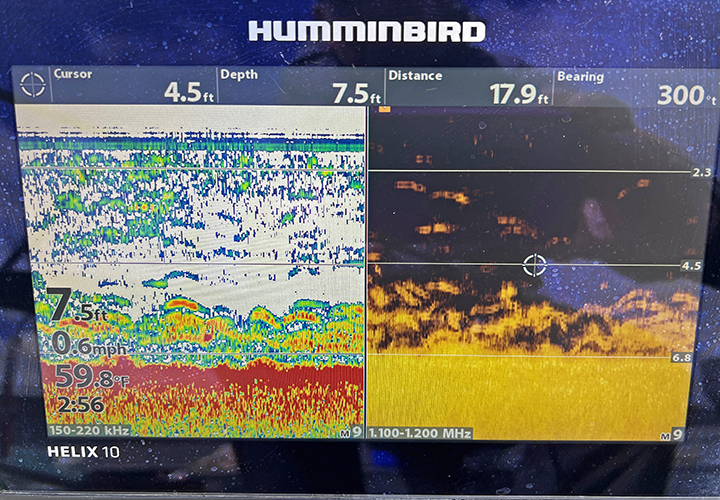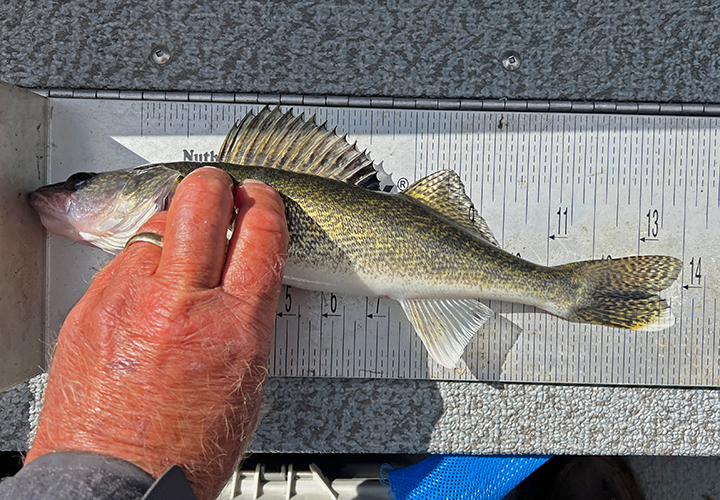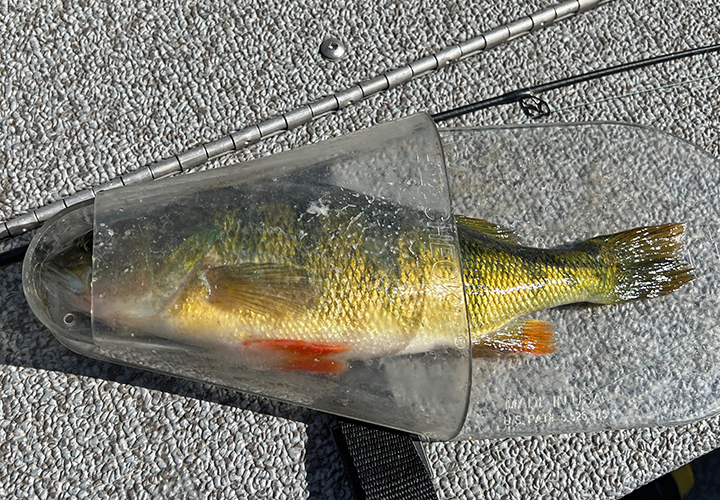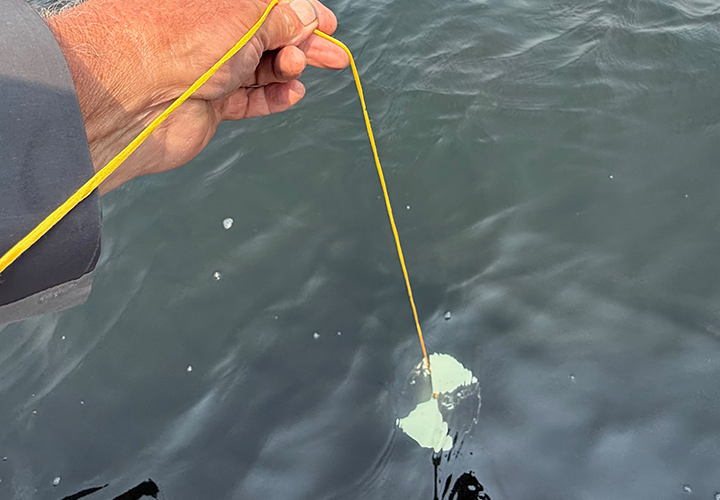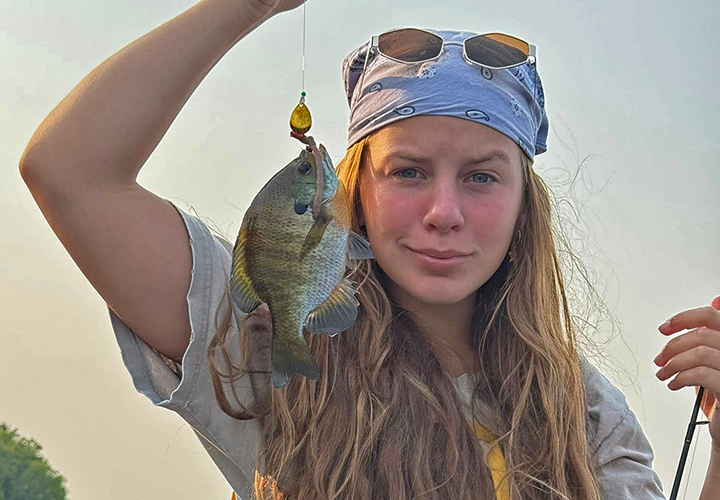Fishing report from Lake Winnie and Cutfoot Sioux for October 3, 2-25
Fall Walleye, Perch, Panfish and Pike Reports From Lake Winnie and Cutfoot Sioux
Lake Winnie and Cutfoot Sioux Fall Fishing Report September 7, 2025
Lake Winnie and Cutfoot Sioux Fall Fishing Report September 7, 2025
Summer is gone and fall rolls into the Lake Winnie region with vengeance. Since our last report, surface water temperatures have declined 10 degrees on average, more than that in select areas. Revealed on the screen of this fisherman’s Humminbird graph, 60.8 degrees was the surface temperature on Winnibigoshish near Stony Point on Saturday. For a moment, a reading of 59.8 degrees flashed across the screen, shown in a separate photo below.
Image of graph screen showing Lake Winnie water temperature on September 6, 2025
The hydrothermal nosedive, brought about by overnight air temperatures in the low 40s and high 30s on Friday-Saturday, is likely to moderate once the weather stabilizes. We do expect to see a rebound that should bring them back into the mid-60-degree range.
Walleye fishing, prior to this cold front had already been better than it had been during the weeks previous. As you’d expect, the action was best on cloudy, breezy days. But even during calm weather, our guests were picking up fish, albeit at a slower rate. The trend, typical of Winnie’s late summer, early fall period was encouraging because it is an early indicator of the start of our “fall walleye bite”. Once folks begin catching some fish on the so-called “off days”, we can count on great fishing when conditions turn favorable.
Image of Jeff, on Lake Winnie fishing trip September 6, 2025
Walleye fishing on the lake this weekend provided more clues that an uptick in walleye activity has been triggered by the falling temperatures. Evident too, was a trend toward one of the classic fall fishing patterns, jigs and minnows. According to one of the local guides, jig and minnow presentations were far better on Saturday than were trolling spinners, his previously accepted best presentation for walleyes. “Just to be sure, we switched back to using spinners in an area where the fish were hitting. On a block long trolling pass, no fish were caught. As soon as we stopped, and resumed jigging, the action picked right back up again,” he commented.
The location, revealed in another screenshot, shows fish of all shapes and sizes that were holding over the tops of mixed wild celery, also known as eelgrass, coontail and other vegetation. Perch, walleyes, northern pike and rock bass cohabitated, and struck at random intervals. Smaller fish dominated the activity, but occasionally high-quality fish were boated too. Both the walleye, and the perch you see pictured here were caught in the same area, within minutes of each other.
Fish over vegetation on Lake Winnie September 6, 2025
The size structure of walleyes from the 2023-year class is improving. Throughout the summer we’ve been monitoring and documenting their growth. This fish, measuring in at 14 inches, is typical of fish from that year class. It is not unreasonable to harvest some of these fish for a meal, and we expect to see some of them in the fish cleaning shack this fall. That said, it would be nice to preserve some of them for one more season so as to let them spawn next spring. Besides the benefit of producing more fish for the future, their average size will improve for the 2026 season, making that an ideal time for harvesting them.
Lake Winnie Walleye class of 2023 now reaching 14 inches
Perch, notably absent from many of our summertime reports, are now showing up in better numbers than before. There are lots of fish in the 6 to 8 inch size range, but also in the mix there are perch in the 10-to-11-inch category. Don’t expect to find giant schools of keeper size fish, but most anglers will gather a batch of a dozen or so good ones on a typical walleye fishing outing. Will targeting them produce larger catches? Maybe, but we haven’t seen evidence of that so far, we’ll keep you posted of those changes.
Lake Winnie Perch
Because of the windy conditions, many anglers spent the last few days fishing for panfish in both Cutfoot and Little Cutfoot Sioux. Nobody has reported catching large numbers of them, but most folks are getting enough fish to make them happy. Crappies, for example, have been available, but not in large numbers. The trade off has been that the average size of crappies is good, with fish in the 11-to-12-inch range in the mix. Most of the better catches have come from Little Cutfoot, rather than big Cutfoot.
Presentations for crappies vary by the day, some folks are catching them by trolling. Spinners, jigs tipped with plastic twirl tails and small crankbaits are all being used to catch fish from the small, scattered schools of fish suspended throughout the water column. When encountering larger than average schools of fish, vertical jigging and slip-bobber presentations have also been effective.
There is no key depth, no key location either; watch your electronics for random packs of fish that are spread out horizontally around the lakes.
Sunfish are more widely dispersed and may be a better alternative for many. The average size of sunfish has been good, with good numbers of harvestable fish in the 8-to-9-inch range. Remember, Cutfoot, Winnibigoshish and all connected waters are now subject to a special regulation on sunfish. Anglers are allowed to harvest no more than 5 sunfish per day.
During mid-summer, trolling spinners tipped with leeches or night crawlers is a good search tool for locating sunfish. But now, with cooler water temperatures trolling should be viewed as a search tool only. Anglers who encounter sunfish will produce better results by stopping the boat, and fishing vertically. Tight lining, using a jig, plain hook, or small jigging rap to fish vertically are good presentations. Tip your lure or hooks with small, cut pieces of night crawler. Hold steady, sunfish prefer slow-and-stationary presentations.
Lake Winnie Northern Pike, Rick Ford September 6, 2025
Northern pike fishing continues to be productive, and in recent days they have provided good action. Most folks are getting pike as they fish for other species, but they could easily be targeted as a primary species. Located in and near the same shallow vegetation where other fish are found, try casting large swim baits. Shad style bodies in the 4-to-6-inch size range are good too, and so are large, shallow running crank baits or jerk baits.
Folks have commented that the northern pike coming from Lake Winnie are well fed, and they are fat. This is good because shorter fish, with heavier girth make better table fare than longer slimmer fish do. You can prove this for yourself, try using a fat 20-to-21-inch fish for blackening. If you harvest a larger, 26 inch plus size pike, use it for broiling, or better yet, to prepare a meal of “coconut pike delight”.
We’re entering an exciting time of the season. Fall colors, cool water fishing patterns and heightened fish activity will combine to make the coming weeks enjoyable. Stay in the loop, we’ll provide updates whenever conditions on the lake change, or enter a new phase.
Cutfoot Sioux and Lake Winnie Fishing Report August 26, 2025
We’re rolling into the Labor Day holiday weekend and fish migrations into early fall locations have begun. Walleyes are pushing toward shoreline flats, perch are becoming active, panfish and bass are feeding more often, and with greater intensity.
Photo courtesy Reed Ylitalo
Walleye fishing has been interesting, ranging between very good, and very tough, depending on when our guests try to catch them. When conditions are favorable, like on cloudy, breezy days, they go on the prowl, feeding heavily as they move along shoreline breaks. Common late summer presentations like trolling spinners, wiggle worming and jig and minnow all work well.
But amateurs and pros alike report that calm water, sunshine or post-cold-front conditions grind the daytime action to a halt. Most folks who are fishing during these times report slow going, no matter which presentation they choose.
One way to tip the scales in favor of reliable walleye action is to focus on fishing during the evening, or even after dark. The natural tendency of walleyes to feed more heavily during these times makes catching them easier. Another way to up the odds of catching walleyes is to wait for “the right day”, and fish for them when they’re most active. The previously mentioned cloudy and breezy conditions, aka walleye chop, are well known for providing the best action on Lake Winnie.
During the off times, there are other species of fish that are more than willing to provide not only action, but excellent table fare as well. Sunfish, most likely the best alternative for warm water, daytime action have been cooperative. The average size of fish has been good, with numbers of harvestable fish in the 8-to-9-inch range. Now, subject to revised limits under Minnesota’s “Quality Sunfish Initiative” there are some fish growing to larger, CPR sizes too. We can’t say that 10-inch sunfish are common yet, but there are enough of them in the system to provide you with a good chance of getting one.
During mid-summer, trolling spinners tipped with leeches or night crawlers is a good search tool for locating sunfish. Water temperatures are cooling though, now holding steady in the 70-to-72-degree range. Trolling can still help you find sunfish, but once they’re located you’ll be better off stopping the boat and fishing more deliberately, using jigs tipped with live bait. Tight lining, dropping the jig over the side of your boat is a good method for catching them. Using floats to suspend your lures in pockets between vegetation can be good too, especially on calm days. Again, small jigs tipped with cut pieces of night crawler work well.
Another great presentation for bobber fishing is to use a plain hook, paired with a few colored beads and a small, flashy spinner blade. Sunfish are curious, and the flashy blade attracts then into the area. Tipping the plain hook with live bait, like small worms, leeches or waxworms trigger them to strike.
Northern pike, fat and chunky, have been active in recent days and offer good action, and good eating too. Most folks are getting pike as they fish for other species, but late summer and early fall are historically great times to target larger fish. Casting and retrieving large lures, bobber fishing with sucker minnows, or using live bait rigs tipped with large creek chubs are all good choices.
Want a great multi-purpose game plan for chasing late summer pike? Try setting up a drift along one of Winnie’s shoreline breaks in water depths of 10 to 14 feet. As you drift, have one or two anglers casting forward, toward the shoreline using bucktails, large spoons or swimbaits. Another angler or two can slip drift using lively sucker minnows. Use large floats like Thills big fish slider, of similar large bobber set to about 6 feet deep. A ½ ounce egg sinker about 18 inches above a large, 4/0 size hook will hold the minnow in place. Often, pike attracted by the casting and retrieving will follow lures but not strike them. The lively minnows provide an alternative for them, and they are frequently caught by the drift rigs.
Largemouth bass are one fish that we don’t mention often enough. Both Cutfoot and Little Cutfoot offer excellent opportunities for catching healthy, good size bass. Even the big lake has some great spots for bass, and anglers willing to explore the outskirts of the lake in back bays and bulrush patches are amazed by the bass fishing opportunities.
During the early morning, topwater, spinnerbaits and other shallow running presentations are effective. But if you really want to catch bass here, learn how to rig and fish with weedless presentations like Texas rigged plastic worms, jigs and pigs, or large swimbaits. Casting into pockets located amongst heavy vegetation like bulrushes, coontail, cabbage and wild rice will produce quality size fish. Avoid areas of soft-mucky bottom and seek out patches of gravel, or light rocks. Most of the better bass fishing will occur here, where hard bottom and vegetation coexist.
There are crappies out there, and if you run into them, they are catchable. Moving along the shoreline breaks in water depths of 8 to 12 feet using spinners or small crankbaits will catch them. So far, nobody has reported locating large schools, or stacks of suspended fish in typical early fall locations. Will there be? It’s hard to say for sure, but the overall population of crappies appears to remain on the lower end of their range. This little fella, found in front of the boat ramp may be a clue that there was a good hatch this spring, and may well represent a future uptick in the crappie population, let’s hope so!
There are still a lot of perch on the small end of the spectrum, too small for harvest. That said, there are also schools of nice fish roaming the flats and hiding in the cabbage patches. Most of the better perch catches come from shallow water, back bays like the Third River, Raven’s Flowage, and Tamarack Bay. Trolling spinners tipped with minnows along the shallow patches of cabbage is a good search method. Once located, jigs tipped with either minnows, or a 2 inch long chunk of night crawler will help you gather a meal.
As fall sets in, begin checking areas of shallow rock and gravel on the big lake. It won’t be long before good catches of perch will come from shallow, 3 to 6 feet of water, especially on breezy, dark days. Shallow cabbage located near bulrush patches will begin producing perch soon too, so start checking areas like these as well.
Is that you saying, “I don’t care about any other fish, I just want walleyes”? Well, okay then, you’ll probably be in luck soon enough. Early every fall, we experience an uptick in the walleye action, and it does appear to be happening already. Like we said, the daytime action depends on weather conditions. Our best advice is that when it’s bright and flat, bide your time and wait to fish during the evening. When the wind starts blowing, get in the boat and go, when conditions are favorable, guides, guests and friends are reporting good walleye action right now.
Trolling spinners tipped with minnows has been reliable, so has trolling with crankbaits. Folks who have forward facing sonar are catching fish using slip floats tipped with leeches. Jigs and minnows are being used effectively by some anglers now too. Getting good minnows has not been easy, but find some golden shiners, rainbows or the largest fatheads you can get, they will work, at least for the time being.
Labor Day marks the transition between the family vacation period, and the arrival of more serious anglers. As the fishing traffic intensifies, we’ll keep you up-to-speed about walleye migrations, fishing patterns and the best presentations. Stay in touch, we’ll be here for you. And by the way, if you’re in the area, stop by the lodge for a visit, we’d be happy to let you in on the freshest news from the lakes.
Winnibigoshish, Cutfoot Sioux, Walleye, Pike and Panfish Report August 8, 2025
Summer fun at the beach far surpasses the pursuit of fish this week. Warm water, sunny skies and calm seas have encouraged our guests to take advantage of the chance to relax on the lake. Still, there are a handful of anglers angling, and for them, results have been mixed.
Autumn Braidey with a 27 inch walleye
Walleye fishing has been both time, and weather dependent. Early morning, or late evening, along with cloudy and breezy days find walleyes active and catchable. Sunshine, calm seas and warm water temperatures send them into the doldrums, and they seemingly disappear.
It can be tempting to use the term “not biting” to describe walleye activity. But biting too well, that is more likely what the problem is. With surface temperatures now ranging between 75 degrees in open water, and 79 degrees in protected, dark water bays and flowages, fish metabolism is running hot. At the same time, food supplies are at their peak and that adds up to easy pickings for active walleyes.
During prime time, walleyes go on the prowl and get all the food they need in short, intense feeding bursts. With stomachs full of food, walleyes simply sit out the periods when conditions do not favor productive feeding. This helps explain why it can be easy to view fish on electronics, but difficult to tease them into striking.
Folks who have fished Winnie for a long time know that this situation is about to change.
With every day that passes, predators consume more baitfish. Insect hatches run their course too, further reducing the available food supplies. Sometime during the next few weeks, reduced food supplies, combined with the early influences of fall will begin shifting the balance. More walleyes will compete for less food, and they will become more vulnerable to angling.
Last week, we mentioned that the Secchi disk reading, taken offshore on Winnie was about 11 feet. Today, thanks to heavy algae blooms, the water clarity is reduced even more. Now we’re looking at water clarity of 8 to 9 feet on the main lake, even less in the dark water flowages and shallow, weedy bays. The reduced clarity, added to walleyes natural instincts to feed will help improve daytime fishing action.
At the time, we wrote, “For now, finding vegetation is one secret to consistent fishing action. Heavy growth, like stands of cabbage and coontail hold perch, sunfish and pike. Less dense stands of submerged plants like flat stemmed pondweed, and other pondweed varieties are holding some crappies, more pike and at times, walleyes.” This advice remains good for folks seeking a mixed bag of “eating size” fish. Finding patches of vegetation, no matter the depth, will be the key to fishing success in the coming days and weeks.
Folks searching for larger fish to catch, photo and release should search for them on the lake’s larger bars. All the names you’ve heard before are in play, Moses Bar, Horseshoe, Bena, Center and Sugar are holding fish. There are fish on some of the larger free-standing humps too, but the smaller ones are less populated with walleyes now.
Spinners, tipped with minnows or night crawlers continue to produce not only walleyes, but pike, perch and panfish too. Spinners will be a mainstay presentation for anglers, as long as water temperatures remain warm. Fishing spinners in deep water require bottom-bouncers, or other heavier weights. In 20 to 25 feet of water, 2 to 2-1/2 bouncers will be ideal. In shallow water, use bullet sinkers in the 1/8 to ¼ ounce range to keep your spinners running above the weed tops.
There are more folks trolling crankbaits on the big lake these days. They are targeting fish that spread out across the flats or spread out horizontally along the secondary breaklines along shore. Key depths range from 12 to 18 feet of water, so crankbaits that run 8 to 12 feet deep are ideal. For some, using planer boards to keep lures running away from their boats is effective. Planer boards, if you have them, can also be used successfully when trolling spinners as well.
Wiggle worming has been a productive presentation for folks who targeted walleyes on Cutfoot Sioux. So has Lindy Rigging with lively leeches, or air injected night crawlers.
Jigs and minnows, while not the favorite crowd during mid-summer are being used by some and have been productive. The best times to try jig and minnow presentations is when there’s a good breeze for drifting. Whether you fish them in the weeds, or over the rocks, they will produce a mixed bag of fish. Getting good minnows is not easy right now, but some of the bait shops offer golden shiners, and others have a “river mix” that includes several varieties of minnows. Select minnows in the 3-to-4-inch size range, and you’ll be okay.
Crappies remain somewhat illusive, but there are more catches being reported now, than there were earlier this summer. Like walleyes, they have been much easier to catch during low-light periods, and we suggest fishing during the early morning. On a calm and quiet morning, baitfish and predators too, can be seen working over the tops, and along the edges of cabbage and coontail beds. Casting spin-jigs like beetle spins or throwing small jigs tipped with plastic tails are productive. A 1/16 or 1/8 ounce live bait jig tipped with ½ night crawler can also be deployed, and will produce a mixed bag of walleye, crappie, sunfish and more.
Anglers complain about a lot of small perch in the system right now. It is true, there are legions of perch in the 5-to-6-inch size range, and recently they have been all too willing to strike. Today’s problem is tomorrow’s solution though, and with all these young perch in the system, we will be enjoying some great perch action in another season or two. In the meantime, there are isolated pods of good size perch, and they are biting. Vegetation like eelgrass, and wild celery seem to hold the better size fish right now, but on windy days, they will roam shallow rock and gravel structures too.
For perching, use spinners tipped with minnows to search for fish. When located, stop and fish with jigs and minnows, lindy rigs with minnows or jigs with cut pieces of night crawlers.
Some folks prefer to focus on northern pike, and we’re seeing an uptick in pike angling, mostly on the big lake. Shoreline patches of cabbage, coontail and pondweeds are holding fish, and are targeted by most. Casting, using jerk-baits, paddle tails and large swim baits has been effective. Trolling with shallow running stick baits, like large rebels, Rapalas and Smithwick’s are productive. Large boobers used to suspend sucker minnows of the weed tops are effective too. When drifting is an option, one angler can watch a bobber while another one, or more, casts for pike.
Alternatives to working the shallow vegetations include trolling crankbaits on the flats, and lindy Rigging with large minnows on the steep drop-offs along mid-lake bars.
Sunfish remain active, and with the warm water, can be easily located using spinners tipped with either night crawlers or small leeches. Toll the edges of vegetation until bluegills are located, then stop the boat and use small jigs tipped with cut pieces of night crawler. Using clip on floats to hold your bait in place can be effective. Also, tight lining with small jigs will be effective. Drop your offering over the side of the boat, hold your rod tip steady and wait for a light tick.
We encourage you to participate in the Minnesota DNR Fisheries Walleye Bag Limit Reduction Proposal Survey. Minnesota DNR Fisheries Chief, Brad Parsons, announced his plans to go forward with a statewide walleye possession limit reduction. The deadline for participation in the online survey is August 15, 2025, and this is your last chance to influence how the formal proposal will be offered.
The official period to receive public comments will come once the formal proposal is introduced. At that time, anglers will have an opportunity to say yes, or no, to whatever formal rules are set into motion.
Regardless of your point of view, be sincere and let the DNR know what it is. We also suggest that you be prepared to make additional comments when the regulatory public comment period begins.







